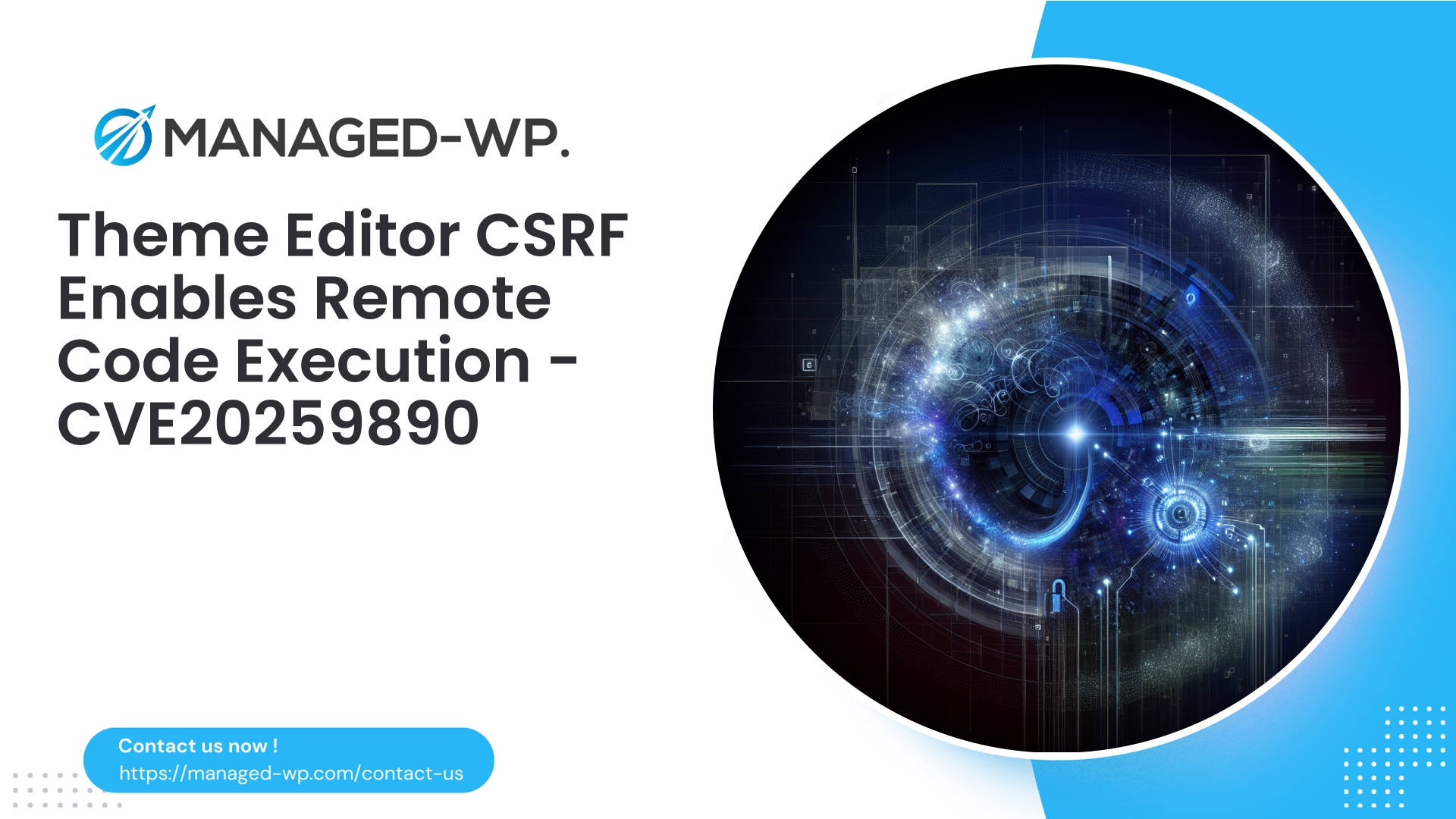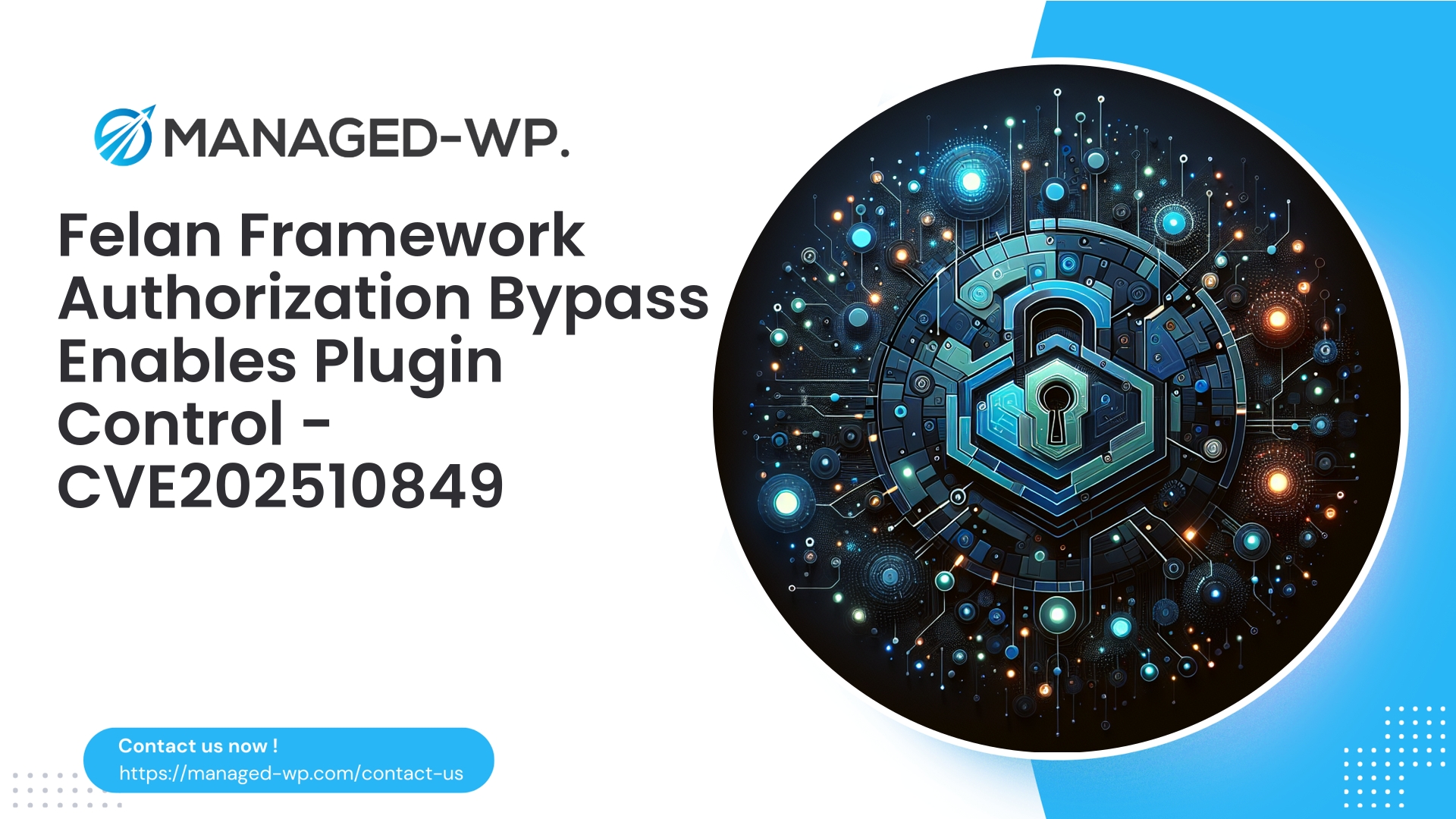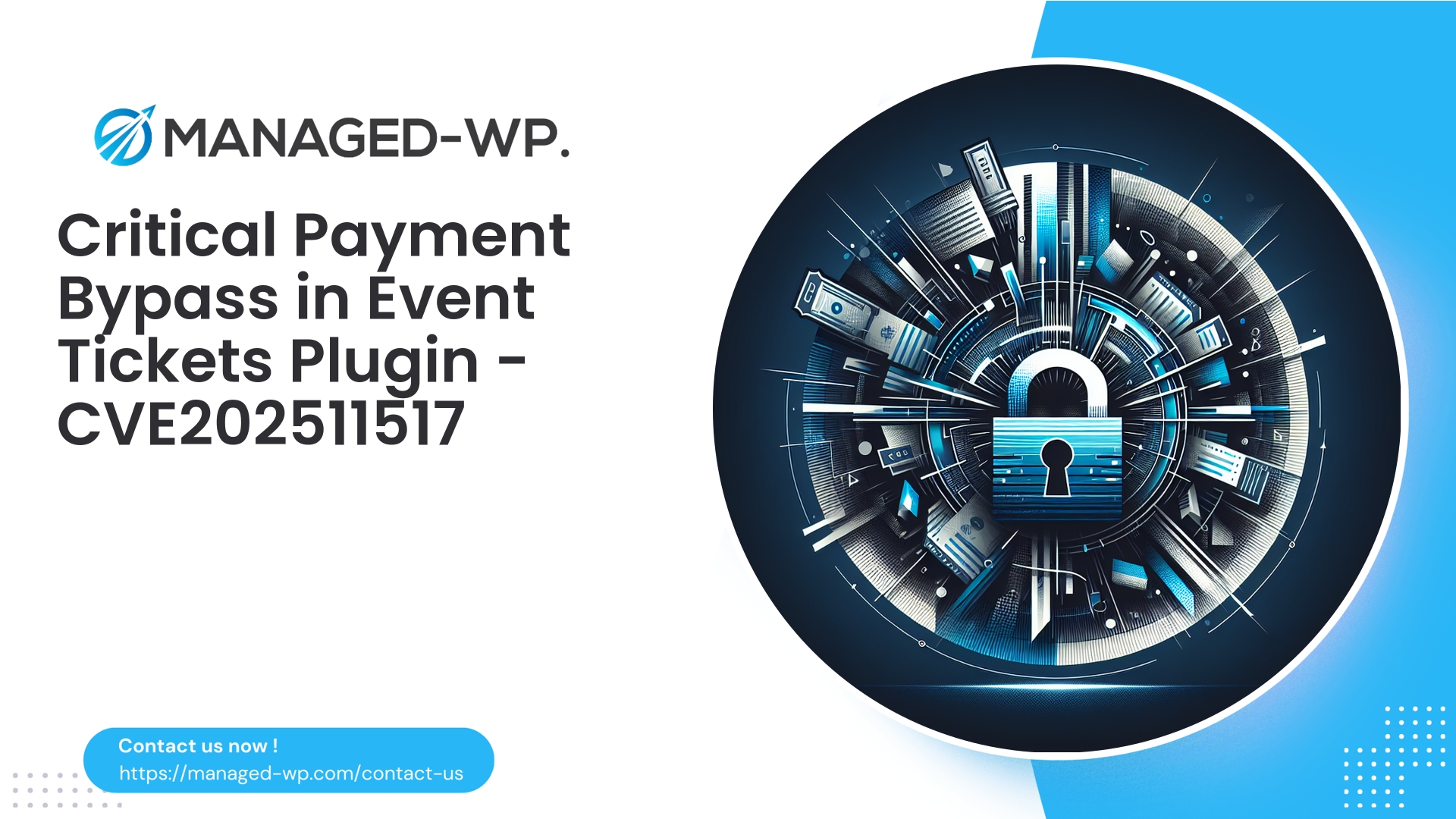| 插件名称 | 主题编辑器 |
|---|---|
| 漏洞类型 | 跨站请求伪造 (CSRF) |
| CVE编号 | CVE-2025-9890 |
| 紧急 | 低的 |
| CVE 发布日期 | 2025-10-18 |
| 源网址 | CVE-2025-9890 |
主题编辑器插件(≤ 3.0)— CSRF 漏洞导致远程代码执行 (CVE-2025-9890):网站所有者必须立即采取的关键措施
作为总部位于美国的网络安全专家 Managed-WP,我们提醒所有 WordPress 管理员和安全专业人员注意一个已被确认为严重漏洞的事件。 CVE-2025-9890此漏洞影响“主题编辑器”插件 3.0 及更低版本,可导致跨站请求伪造 (CSRF) 攻击,并可能升级为远程代码执行 (RCE)。虽然插件作者已在 3.1 版本中发布了补丁,但对于运行早期版本的网站而言,风险依然十分严重。
在本详细简报中,我们将解读漏洞,概述可能的利用策略,提供深入的检测和修复指南,并推荐纵深防御策略,包括 Managed-WP 部署的托管 WAF 缓解措施,以保护客户。本简报面向管理 WordPress 环境的网站管理员、顾问和开发人员。
要点概览
- 漏洞类型: 跨站请求伪造 (CSRF) 导致远程代码执行 (RCE)
- 受影响版本: 主题编辑器插件版本≤3.0
- 补丁状态: 已在 3.1 版本中修复
- CVE标识符: CVE-2025-9890
- 探索信用: 安全研究员(姓名不详)
- 直接风险: 通过特权或未经身份验证的访问点进行任意 PHP 代码注入和文件修改
为什么这种漏洞需要立即关注
WordPress 的主题和插件编辑器拥有强大的权限——尤其值得一提的是,它们能够直接在服务器上编写或修改 PHP 文件。如果这种权限被利用,攻击者可以植入恶意代码,从而危及整个网站甚至底层服务器基础设施的安全。
虽然问题的根源在于跨站请求伪造 (CSRF) 漏洞,但它与暴露的文件写入端点结合使用,会使其成为远程代码执行的入口。必须立即采取全面干预措施:更新插件、实施防火墙保护并进行彻底的安全审计。
技术解析:从 CSRF 到完全 RCE
CSRF 攻击成功的原因在于恶意攻击者诱骗已登录用户或利用防护不足的端点执行未经授权的操作。有效的防御措施包括:
- 严格的能力验证(例如,
current_user_can('edit_theme_options')). - 通过稳健的 nonce 检查
wp_verify_nonce()任何状态变更请求。 - 补充HTTP方法和引用页验证。
主题编辑器插件未能对修改 PHP 文件的端点强制执行这些控制措施,这使得攻击者能够:
- 诱使特权用户无意中注入恶意 PHP 后门。
- 利用公共或未经身份验证的 API 端点直接编写可执行代码。
该漏洞已通过以下方式跟踪: CVE-2025-9890 并展示了受损的访问控制和缺少 nonce 验证如何导致危险的攻击途径。
潜在攻击场景
-
通过已认证管理员发起的 CSRF 攻击
- 攻击者诱骗管理员访问精心制作的网页或电子邮件。
- 如果没有进行适当的 nonce/能力验证,该请求会将恶意 PHP 有效载荷发送到主题文件。
- 会导致安装 webshell,从而使攻击者获得对网站的完全控制权。
-
利用未经认证的端点
- 如果插件端点缺少身份验证,攻击者无需用户交互即可直接注入恶意代码。
- 这会立即造成全面泄露的风险。
-
将 CSRF 与其他漏洞相结合的连锁攻击
- 攻击者可能会利用此漏洞作为跳板,在网站或服务器内进行权限提升、持久化或横向移动。
剥削行为的发生得益于以下因素:
- 插件文件写入功能授权检查不足。
- 以管理员身份登录的浏览器访问恶意网站。
- 缺少主动式 Web 应用程序防火墙 (WAF) 或文件完整性监控解决方案的网站。
场地所有者应立即采取的补救措施(接下来 60 分钟)
- 将主题编辑器插件升级到 3.1 或更高版本。
- 使用 WordPress 管理界面或 WP-CLI 可以快速更新插件。
- 如果无法立即更新,请禁用或停用该插件。
- 移除易受攻击的端点,减少攻击面。
- 禁用内置主题和插件编辑器,作为一项纵深防御措施:
定义('DISALLOW_FILE_EDIT',true); - 如果怀疑网站遭到入侵,请将其置于维护或受限模式。
- 立即应用 Managed-WP 推荐的 WAF 规则。
- 过滤并阻止危险的 POST 请求,并强制执行 nonce 验证。
- 强制重置凭证并轮换所有密钥。
- 按照以下详细说明执行入侵指标 (IOC) 扫描。
- 如果检测到系统遭到入侵,则从已验证的干净备份中恢复。
- 如果确认存在恶意活动,请遵循完整的事件响应流程。
检测和入侵指标 (IOC)
检查您的网站是否存在以下危险信号,以确定在修复补丁之前是否发生过漏洞利用:
文件系统检查
- 搜索主题和插件目录中最近修改过的 PHP 文件:
find wp-content/themes -type f -name '*.php' -mtime -30 -ls find wp-content/plugins -type f -name '*.php' -mtime -30 -ls - 扫描 webshell 中常用的可疑 PHP 函数:
grep -R --line-number -E "eval\(|base64_decode\(|gzinflate\(|str_rot13\(|create_function\(|preg_replace\(.*/e" wp-content - 识别上传目录中意外出现的 PHP 文件:
查找 wp-content/uploads -type f -name '*.php'
数据库和用户检查
- 查找最近添加的或可疑的管理员用户:
SELECT ID, user_login, user_registered FROM wp_users WHERE user_registered >= '2025-10-01' ORDER BY user_registered DESC;
日志和HTTP请求分析
- 检查 Web 服务器日志,查找针对插件端点(例如 admin-post.php、admin-ajax.php)的可疑 POST 请求。
- 识别异常的引荐来源、用户代理或快速重复的 POST 提交。
运行时异常
- 意外的出站流量或 DNS 查询。
- CPU或磁盘使用率激增与可疑的文件更改同时发生。
- 未知计划任务或 WP-Cron 作业正在执行可疑代码。
重要的: 在进行任何清理行动之前,请保留所有日志和取证证据。
托管WP推荐的WAF防御策略(虚拟修补)
通过 Web 应用程序防火墙进行虚拟修补,可以在攻击尝试到达易受攻击的代码之前将其拦截,从而大幅降低风险。
核心WAF建议
- 除非附带有效的 WordPress nonce,否则阻止针对主题编辑器端点的 POST 请求。
- 拒绝或限制外部引用者对文件写入端点的访问。
- 限制或屏蔽可疑的IP地址和自动用户代理。
- 扫描 POST 请求负载,查找常见的 PHP 注入特征,例如:
<?php,评估(,base64_decode(以及相关模式。 - 在网络边缘强制执行身份验证检查——阻止所有未经身份验证的尝试。
ModSecurity 风格规则示例
# 阻止对主题编辑器文件写入端点的可疑 POST 请求 SecRule REQUEST_URI "@rx /wp-content/plugins/theme-editor/.*(edit|save|update|write).*" \ "phase:2,deny,log,status:403,id:1009001,msg:'已阻止潜在的主题编辑器文件写入',\ chain" SecRule REQUEST_METHOD "POST" \ "chain" SecRule ARGS|REQUEST_BODY "@rx <\?php|eval\(|base64_decode\(|gzinflate\(|system\(|exec\(" \ "t:none,deny,log"
# 强制主题编辑器 POST 操作必须包含 WP nonce 安全规则 REQUEST_URI "@contains /wp-content/plugins/theme-editor/" \ "phase:2,chain,pass,id:1009002,msg:'主题编辑器操作需要 WP nonce'" 安全规则 ARGS_NAMES "@contains _wpnonce" "t:none,pass" # 缺少 _wpnonce 的请求将被阻止
Managed-WP 客户可以受益于这些虚拟补丁的自动推送,以及检测和自动修复工具。
综合补救清单
- 请将主题编辑器插件更新至 3.1 或更高版本。
- 如果无法立即应用更新,请暂时停用该插件。
- 应用针对易受攻击的端点和注入有效载荷的托管 WP WAF 规则。
- 禁用所有 WordPress 文件编辑器:
定义('DISALLOW_FILE_EDIT',true); - 强制执行密码重置,并轮换所有身份验证密钥和盐值。
- 对入侵迹象进行彻底扫描(参见检测部分)。
- 如果确认系统已遭入侵,则从干净的备份中恢复;否则,执行完整的手动清理。
- 继续监控是否存在反复攻击尝试和残留漏洞的迹象。
- 今后应定期安排完整性扫描。
安全团队高效日志搜寻查询
Apache/Nginx 日志示例:
- 查找针对主题编辑器端点的 POST 活动:
- /wp-content/plugins/theme-editor/**/save
- /wp-admin/admin-ajax.php?action=theme_editor_save
- 识别包含 PHP 代码的可疑 multipart POST 请求:
# 过滤针对主题编辑器插件的 POST 请求 grep -i "POST .*theme-editor" /var/log/apache2/access.log* | less # 提取包含 PHP 注入载荷的 POST 请求 zcat /var/log/apache2/access.log.*.gz | grep -i --line-buffered -P "(POST .*theme-editor|<\?php)"
同时查看 WordPress 调试日志和插件特定日志,以发现异常情况。
避免 CSRF 到 RCE 漏洞的开发者最佳实践
插件和主题开发者在实现文件编辑功能时,必须严格执行安全控制措施:
- 能力强制执行:
- 始终使用最严格的规则
当前用户可以()权限检查。
- 始终使用最严格的规则
- Nonce 验证:
- 为所有状态改变操作颁发并验证 nonce。
- 最小文件写入风险:
- 限制文件编辑范围,仅允许编辑白名单中的文件和目录。
- 彻底消毒输入物:
- 避免
eval()或执行用户输入的类似函数。
- 避免
- 使用 WP 文件系统 API:
- 尽量使用官方 API,而不是直接调用文件系统。
- 最小特权原则:
- 绝不允许未经身份验证的写入操作,并尽可能限制权限。
- 审计日志记录:
- 维护文件更改和用户管理操作的详细日志。
- 安全默认设置:
- 考虑默认禁用文件编辑器;需要管理员明确选择启用。
事件响应手册:管理未经授权的代码发现
- 将网站置于维护模式,停止外部交互。
- 对网站数据和日志进行完整备份;仔细保存证据。
- 获取文件和数据库的完整快照。
- 识别攻击向量:插件端点、被盗用的凭证或其他入侵点。
- 通过移除 webshell 和后门进行清理,或者从经过验证的干净备份中恢复。
- 重置 WordPress 用户、FTP/SFTP、主机控制面板和数据库中的所有密码。
- 轮换所有敏感的API密钥和密钥。
- 在配置文件中安全地更新 WordPress salts。
- 使用 DISALLOW_FILE_EDIT 强化环境,更新插件/主题/核心,并强制执行 WAF 策略。
- 事件发生后至少进行90天的持续监测。
遇到持续或复杂的安全漏洞时,应寻求专业事件响应人员的帮助。
虚拟修补的重要性不仅限于更新
应用厂商提供的补丁(版本 3.1)可以解决代码问题,但并不能消除可能已存在的网站安全漏洞。攻击者通常会在补丁发布前部署后门,因此需要主动检测和清除。
- 虚拟补丁增加了一层至关重要的安全保障,可以立即阻止攻击尝试。
- 它既能减少攻击面,又能在修复过程中保护网站安全。
- 虚拟补丁是对及时插件更新的补充,但不能取代及时的插件更新。
Managed-WP 结合了更新强制执行、虚拟修补和完整性监控,大大降低了整体风险。
快速硬化建议
- 始终运行最新受支持的 WordPress 内核版本,并及时更新。
- 保持插件和主题更新;删除任何未使用或已弃用的插件和主题。
- 对所有管理员帐户强制执行强密码和双因素身份验证。
- 在生产环境中禁用文件和插件编辑器:
define('DISALLOW_FILE_EDIT', true); define('DISALLOW_FILE_MODS', true); # 防止未经授权的插件/主题安装和更新 - 设置安全的文件权限(例如,文件权限为 644,目录权限为 755;将 wp-config.php 的权限限制为 600)。
- 部署托管式Web应用防火墙和强大的恶意软件扫描解决方案。
- 定期安排备份和恢复测试,以确保恢复准备就绪。
- 维护详细日志,集中保留至少 90 天。
修复后监测要点
- 密切监控日志,以发现反复出现的攻击尝试。
- 定期对主题和插件目录进行文件完整性检查。
- 安排持续的漏洞扫描和合规性审计。
免费试用 Managed-WP — 必备 WordPress 安全解决方案
我们的免费托管 WordPress 方案可立即保护您免受 CVE-2025-9890 等关键漏洞的侵害。功能包括托管防火墙、无限带宽、强大的 WAF 规则、恶意软件扫描以及针对 OWASP Top 10 核心威胁的缓解措施。只需几分钟即可完成设置,立即保护您的网站边缘安全: https://my.wp-firewall.com/buy/wp-firewall-free-plan/
如需增强保护功能,包括自动虚拟补丁、定期安全报告和专用团队工作流程,请了解我们的付费 Managed-WP 计划。
最后注意事项——务必极其谨慎地使用代码编辑插件
允许直接编辑或创建 PHP 代码的插件存在固有的安全风险,需要多层控制:
- 严格执行能力和随机数要求。
- 全面的输入验证和清理。
- 遵循最小权限设计原则,并采用安全的默认设置。
- 主动监控和事件响应准备。
作为网站管理员和安全从业人员,你们的职责是:
- 及时修补漏洞并部署安全控制措施。
- 利用托管式 WAF 服务来限制暴露窗口。
- 在审计结果证明无违规之前,假定存在违规行为。
- 实施严格的监控和强化流程。
在 Managed-WP,我们的安全工程师持续监控新出现的漏洞,并主动为广泛部署且已被积极利用的威胁提供虚拟补丁。如果您的网站运行了此插件,请联系我们,我们将为您提供检测、清理和加固方面的专家协助。
保持警惕,及时修补 WordPress 生态系统中的漏洞,并将高风险文件编辑功能的使用限制在受信任的管理员范围内。



















